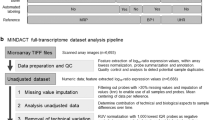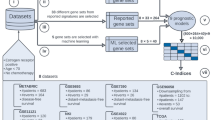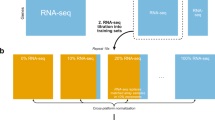Abstract
Measurement of gene-expression profiles using microarray technology is becoming increasingly popular among the biomedical research community. Although there has been great progress in this field, investigators are still confronted with a difficult question after completing their experiments: how to validate the large data sets that are generated? This review summarizes current approaches to verifying global expression results, discusses the caveats that must be considered, and describes some methods that are being developed to address outstanding problems.
This is a preview of subscription content, access via your institution
Access options
Subscribe to this journal
Receive 12 print issues and online access
$209.00 per year
only $17.42 per issue
Buy this article
- Purchase on SpringerLink
- Instant access to full article PDF
Prices may be subject to local taxes which are calculated during checkout

Katie Ris

Similar content being viewed by others
References
Churchill, G.A. Fundamentals of experimental design for cDNA microarrays. Nature Genet. 32, 490–495 (2002).
Quackenbush, J. Microarray data normalization and transformation. Nature Genet. 32, 496–501 (2002).
Stoeckert, C.J., Causton, H.C. & Ball, C.A. Microarray databases: standards and ontologies. Nature Genet. 32, 469–473 (2002).
Holloway, A.J., Murphy, M. & Bowtell, D.D.L. Options available—from start to finish—for obtaining data from DNA microarrays. Nature Genet. 32, 481–489 (2002).
Slonim, D.K. From patterns to pathways: gene-expression data analysis comes of age. Nature Genet. 32, 502–508 (2002).
Hess, K.R., Zhang, W., Baggerly, K.A., Stivers, D.N. & Coombes, K.R. Microarrays: handling the deluge of data and extracting reliable information. Trends Biotechnol. 19, 463–468 (2001).
Pan, W. A comparative review of statistical methods for discovering differentially expressed genes in replicated microarray experiments. Bioinformatics 18, 546–554 (2002).
Nadon, R. & Shoemaker, J. Statistical issues with microarrays: processing and analysis. Trends Genet. 18, 265–271 (2002).
Mills, J.C., Roth, K.A., Cagan, R.L. & Gordon, J.I. DNA microarrays and beyond: completing the journey from tissue to cell. Nature Cell Biol. 3, 175–178 (2001).
Mutch, D.M., Berger, A., Mansourian, R., Rytz, A. & Roberts, M.A. Microarray data analysis: a practical approach for selecting differentially expressed genes. Genome Biol. 2, preprint0009 (2001).
Ellis, M. et al. Development and validation of a method for using breast core needle biopsies for gene expression microarray analyses. Clin. Cancer Res. 8, 1155–1166 (2002).
Luo, J. et al. Human prostate cancer and benign prostatic hyperplasia: molecular dissection by gene expression profiling. Cancer Res. 61, 4683–4688 (2001).
Welsh, J.B. et al. Analysis of gene expression identifies candidate markers and pharmacological targets in prostate cancer. Cancer Res. 61, 5974–5978 (2001).
LaTulippe, E. et al. Comprehensive gene expression analysis of prostate cancer reveals distinct transcriptional programs associated with metastatic disease. Cancer Res 62, 4499–4506 (2002).
Dhanasekaran, S.M. et al. Delineation of prognostic biomarkers in prostate cancer. Nature 412, 822–826 (2001).
Emmert-Buck, M.R. et al. Molecular profiling of clinical tissue specimens: feasibility and applications. Am. J. Pathol. 156, 1109–1115 (2000).
Magee, J.A. et al. Expression profiling reveals hepsin overexpression in prostate cancer. Cancer Res. 61, 5692–5696 (2001).
Stamey, T.A. et al. Molecular genetic profiling of Gleason grade 4/5 prostate cancers compared to benign prostatic hyperplasia. J. Urol. 166, 2171–2177 (2001).
Ahram, M. et al. Proteomic analysis of human prostate cancer. Mol. Carcin. 33, 9–15 (2001).
Singh, D. et al. Gene expression correlates of clinical prostate cancer. Cancer Cell 1, 203–209 (2002).
Svaren, J. et al. EGR1 target genes in prostate carcinoma cells identified by microarray analysis. J. Biol. Chem. 275, 38524–38531 (2000).
Chaib, H., Cockrell, E.K., Rubin, M.A. & Macoska, J.A. Profiling and verification of gene expression patterns in normal and malignant human prostate tissues by cDNA microarray analysis. Neoplasia 3, 43–52 (2001).
Porkka, K., Saramaki, O., Tanner, M. & Visakorpi, T. Amplification and overexpression of Elongin C gene discovered in prostate cancer by cDNA microarrays. Lab. Invest. 82, 629–637 (2002).
Mousses, S. et al. Clinical validation of candidate genes associated with prostate cancer progression in the CWR22 model system using tissue microarrays. Cancer Res. 62, 1256–1260 (2002).
Rhodes, D., Barrette, T., Rubin, M.A., Ghosh, D. & Chinnaiyan, A.M. Meta-analysis of microarrays: interstudy validation of gene expression profiles reveals pathway dysregulation in prostate cancer. Cancer Res. 62, 4427–4433 (2002).
Canada, A.T. et al. Glutathione and glutathione S-transferase in benign and malignant prostate cell lines and prostate tissues. Biochem. Pharmacol. 51, 87–90 (1996).
Al Moustafa, A.E. et al. Identification of genes associated with head and neck carcinogenesis by cDNA microarray comparison between matched primary normal epithelial and squamous carcinoma cells. Oncogene 21, 2634–2640 (2002).
Bangur, C.S. et al. Identification of genes over-expressed in small cell lung carcinoma using suppression subtractive hybridization and cDNA microarray expression analysis. Oncogene 21, 3814–3825 (2002).
Alevizos, I. et al. Oral cancer in vivo gene expression profiling assisted by laser capture microdissection and microarray analysis. Oncogene 20, 6196–6204 (2001).
Luo, J.H. et al. Gene expression analysis of prostate cancer. Mol. Carcin. 33, 25–35 (2002).
Jiang, Y. et al. Discovery of differentially expressed genes in human breast cancer using subtracted cDNA libraries and cDNA microarrays. Oncogene 21, 2270–2282 (2002).
Scheidl, S.J. et al. mRNA expression profiling of laser microbeam microdissected cells from slender embryonic structures. Am. J. Pathol. 160, 801–813 (2002).
Amundson, S.A. et al. Fluorescent cDNA microarray hybridization reveals complexity and heterogeneity of cellular genotoxic responses. Oncogene 18, 3666–3672 (1999).
Clark, J. et al. Identification of amplified and expressed genes in breast cancer by comparative hybridization onto microarrays of randomly selected cDNA clones. Genes, Chromosomes Cancer 34, 104–114 (2002).
Rajeevan, M.S., Vernon, S.D., Taysavang, N. & Unger, E.R. Validation of array-based gene expression profiles by real-time (kinetic) RT-PCR. J. Mol. Diagnosis 3, 26–31 (2001).
Ross, D.T. et al. Systematic variation in gene expression patterns in human cancer cell lines. Nature Genet. 24, 227–235 (2000).
Taniguchi, M., Miura, K., Iwao, H. & Yamanaka, S. Quantitative assessment of DNA microarrays—comparison with Northern blot analyses. Genomics 71, 34–39 (2001).
Sgroi, D.C. et al. In vivo gene expression profile analysis of human breast cancer progression. Cancer Res. 59, 5656–5661 (1999).
Vu, H.L., Troubetzkoy, S., Nguyen, H.H., Russell, M.W. & Mestecky, J. A method for quantification of absolute amounts of nucleic acids by (RT)-PCR and a new mathematical model for data analysis. Nucleic Acids Res. 28, E18 (2000).
Nacht, M. et al. Molecular characteristics of non-small cell lung cancer. Proc. Natl Acad. Sci. USA 98, 15203–15208 (2001).
Walker, N. A technique whose time has come. Science 296, 557–558 (2002).
Kononen, J. et al. Tissue microarrays for high-throughput molecular profiling of tumor specimens. Nature Med. 4, 844–847 (1998).
Kallioniemi, O.P., Wagner, U., Kononen, J. & Sauter, G. Tissue microarray technology for high-throughput molecular profiling of cancer. Hum. Mol. Genet. 10, 657–662 (2001).
Hoos, A. & Cordon-Cardo, C. Tissue microarray profiling of cancer specimens and cell lines: opportunities and limitations. Lab. Invest. 81, 1331–1338 (2001).
Fejzo, M. & Slamon, D.J. Frozen tumor tissue microarray technology for analysis of tumor RNA, DNA, and proteins. Am. J. Pathol. 159, 1645–1650 (2001).
Bubendorf, L. et al. Hormone therapy failure in human prostate cancer: analysis by complementary DNA and tissue microarrays. J. Natl Cancer Inst. 91, 1758–1764 (1999).
Battifora, H. The multitumor (sausage) tissue block: novel method for immunohistochemical antibody testing. Lab. Invest. 55, 244–248 (1986).
Emmert-Buck, M.R. et al. Laser capture microdissection. Science 274, 998–1001 (1996).
Bonner, R.F. et al. Laser capture microdissection: molecular analysis of tissue. Science 278, 1481–1483 (1997).
Paweletz, C.P. et al. Reverse phase protein microarrays which capture disease progression show activation of pro-survival pathways at the cancer invasion front. Oncogene 20, 1981–1989 (2001).
Petricoin, E.F. et al. Medical applications of microarrays: a regulatory science perspective. Nature Genet. 32, 474–479 (2002).
Brown Jones, M. et al. The granulin-epithelin precursor/PC-cell derived growth factor is a growth factor for epithelial ovarian cancer. Clin. Cancer Res. In press.
Cole, K.A., Krizman, D.B. & Emmert-Buck, M.R. The genetics of cancer—a 3D model. Nature Genet. 21, 38–41 (1999).
Luo, L. et al. Gene expression profiles of laser-captured adjacent neuronal subtypes. Nature Med. 5, 117–122 (1999).
Luzzi, V., Holtschlag, V. & Watson, M.A. Expression profiling of ductal carcinoma in situ by laser capture microdissection and high-density oligonucleotide arrays. Am. J. Pathol. 158, 2005–2010 (2001).
Leethanakul, C. et al. Distinct pattern of expression of differentiation and growth-related genes in squamous cell carcinomas of the head and neck revealed by the use of laser capture microdissection and cDNA arrays. Oncogene 19, 3220–3224 (2000).
Van Gelder, R. et al. Amplified RNA synthesized from limited quantities of heterogeneous cDNA. Proc. Natl Acad. Sci. USA 87, 1663–1667 (1990).
Englert, C.R., Baibakov, G.V. & Emmert-Buck, M.R. Layered expression scanning: rapid molecular profiling of tumor samples. Cancer Res. 60, 1526–1530 (2000).
Emmert-Buck, M.R. et al. An approach to proteomic analysis of human tumors. Mol. Carcin. 27, 158–165 (2000).
Ornstein, D.K. et al. Proteomic analysis of laser capture microdissected prostate cancer and in vitro cell lines. Electrophoresis 21, 2235–2242 (2000).
Carlisle, A. et al. Development of a prostate cDNA microarray and statistical gene expression analysis package. Mol. Carcin. 27, 1–11 (2000).
Strausberg, R.L., Buetow, K.H., Emmert-Buck, M.R. & Klausner, R.D. The cancer genome anatomy project: building an annotated gene index. Trends Genet. 16, 103–106 (2000).
Paweletz, C.P. et al. Loss of annexin 1 correlates with early onset of tumorigenesis in esophageal and prostate carcinoma. Cancer Res. 60, 6293–6297 (2000).
Kang, J. et al. Dysregulation of annexin I protein expression in high-grade prostatic intraepithelial neoplasia and prostate cancer. Clin. Cancer Res. 8, 117–123 (2002).
Fend, F. et al. Immuno-LCM: laser capture microdissection of immunostained frozen sections for mRNA analysis. Am. J. Pathol. 154, 61–66 (1999).
Hodge, D.L. et al. IL-2 and IL-12 alter NK cell responsiveness to IFN-gamma-inducible protein 10 by down-regulating CXCR3 expression. J. Immunol. 168, 6090–6098 (2002).
Saban, M.R. et al. Time course of LPS-induced gene expression in a mouse model of genitourinary inflammation. Physiol. Genomics 5, 147–160 (2001).
Bonaventure, P. et al. Nuclei and subnuclei gene expression profiling in mammalian brain. Brain Res. 943, 38–47 (2002).
Qi, Z.Y. et al. Isolation of novel differentially expressed genes related to human glioma using cDNA microarray and characterizations of two novel full-length genes. J. Neurooncol. 56, 197–208 (2002).
Burton, G.R., Guan, Y., Nagarajan, R. & McGehee, R.E. Microarray analysis of gene expression during early adipocyte differentiation. Gene 293, 21–31 (2002).
Author information
Authors and Affiliations
Corresponding author
Ethics declarations
Competing interests
Michael Emmert-Buck is an inventor on multiple allowed patents and patent applications covering LCM, LES, and expression microdissection, and is entitled to receive royalty payments through the NIH technology transfer program. LCM is licensed by Arcturus Engineering (http://www.arctur.com). LES is licensed by 20/20 GeneSystems (http://www.2020gene.com).
Rights and permissions
About this article
Cite this article
Chuaqui, R., Bonner, R., Best, C. et al. Post-analysis follow-up and validation of microarray experiments. Nat Genet 32 (Suppl 4), 509–514 (2002). https://doi.org/10.1038/ng1034
Issue Date:
DOI: https://doi.org/10.1038/ng1034



